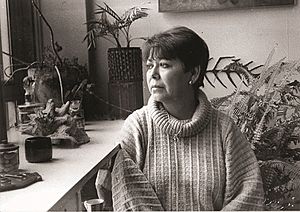Herlinda Sánchez Laurel facts for kids
Herlinda Sánchez Laurel (born May 24, 1941 – died February 21, 2019) was a Mexican artist and a professor. She taught art at the National Autonomous University of Mexico. Her amazing work was recognized by many groups. She was a member of the Salón de la Plástica Mexicana. She also won awards from the state of Baja California and the Palacio de Bellas Artes.
Her Early Life
Herlinda Sánchez Laurel was born in Ensenada, Baja California. This city is in the Mexican state of Baja California. She went to school there. First, she studied to become a secretary. Then, she studied banking.
But something special happened. She won first prize in a state art competition! This made her decide to become an artist. In 1965, she moved to Mexico City. There, she studied art at the Escuela Nacional de Pintura, Escultura y Grabado "La Esmeralda". She finished her studies in 1969.
After art school, she went back to Ensenada for a short time. She worked on a large painting called a mural there. In 1971, she moved back to Mexico City for good. She lived there until she passed away.
Her Art Career
Herlinda Sánchez Laurel started her art career right after she graduated. From 1969 to 1970, she painted a mural. It was called "Alegoría a la lucha" (Allegory of the Struggle). She painted it for the State Teachers' Union in Ensenada.
In 1971, she started teaching art. She taught at the Casa del Lago in Chapultepec Park. This place is part of the National Autonomous University of Mexico. She also worked as a graphic designer for the university. In 1987, she began teaching at the Escuela Nacional de Artes Plásticas. Later, in 1995, she started doing research work there. She also gave talks about art in different parts of Mexico.
Her first art show was in 1969. It was at the Universidad Autónoma de Baja California. Her second show was in 1974 in Mexico City. Throughout her career, she had over 35 individual art shows. She also took part in more than 150 group shows. These shows were in Mexico and other countries.
Her art can be seen in many important places. Some of these include the Museo de Arte Moderno and the modern art museum of the State of Mexico. Her work is also in many private collections.
Besides painting, Herlinda Sánchez Laurel also worked as an illustrator. From 1973 to 1976, she illustrated textbooks. These were for the Secretaría de Educación Pública. She also did design work for publishing companies. Since 1979, she worked on her own as an illustrator.
She was also a respected judge for art competitions. She helped judge many events across Mexico.
Awards and Tributes
Herlinda Sánchez Laurel received many awards for her art.
- In 1980 and 1983, she won prizes from the Salón Nacional de Artes Plásticas.
- She won the Salón de Dibujo in 1985.
- In 1991, she received the Paris Prize.
- She was also a member of the Salón de la Plástica Mexicana.
- In 2003, she won the Cuatlícue Prize.
- The Tec de Monterrey, Mexico City Campus held a special show and tribute for her.
- In 2002, the state of Baja California honored her career.
- The Palacio de Bellas Artes also paid tribute to her in 2003.
- In 2005, she received the Sor Juana Inés de la Cruz Medal from UNAM. This was for her long teaching career.
Her Art Style
Herlinda Sánchez Laurel's art is called "figurative." This means her paintings show things that look like real objects or people. She believed that art is most beautiful when not everything is shown clearly. She thought that symbols were as important as colors in her art.
She created paintings using oil paints and encaustic. Encaustic is a special way of painting with heated wax. She also made prints. Her art was influenced by famous artists like Georges Braque and Paul Klee. She also admired Mexican artists such as Rufino Tamayo and Francisco Toledo.
During the student protests in Mexico in 1968, Herlinda Sánchez Laurel played an important role. She was the president of the La Esmeralda art school. She helped organize and protect art from that time. She saved 65 original art plates. This helped people understand the role of artists, especially women artists, during that period. This collection of art is known as "Gráfica del 68."
See also
 In Spanish: Herlinda Sánchez Laurel para niños
In Spanish: Herlinda Sánchez Laurel para niños


